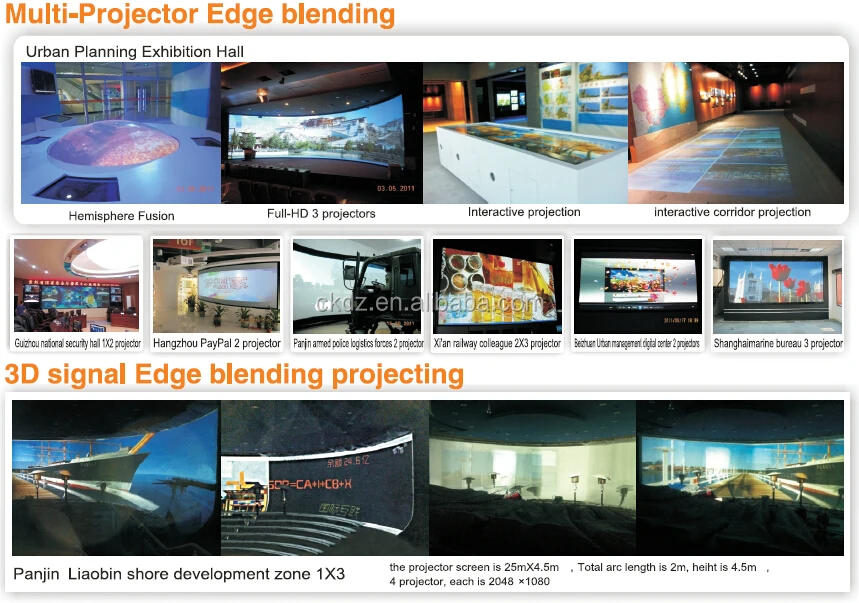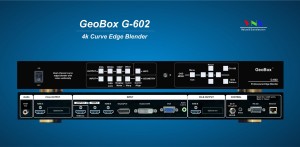Edge blending, that is, the two images into a region of overlap, which overlaps the region of the signal, according to a linear relationship between the fusion fade, makes a direct overlap between the “light zone” effects as much as possible to eliminate in order to achieve real seamless effect. G802 is dual channel processor with the ability for warp, geometry alignment, image stacking, edge blending and edge mask.etc. It can control up to two projectors. Four inputs, two outputs and one loop out port are designed in G802. User can display one big edge blended image or two independent displays in one system. GeoBox - M801 - Edge blending processor M800 is curved screen edge blending processor with the ability to provide multiple processing modules to control from 1 to 4 projectors based on user’s requirements. User can combine the images on the ceiling, wall and floor to create immersive display through GeoBox edge blending technology. It is world unique technology to setup all kinds of edge blending and immersive system through remote controller without PC. There are two edge blending product lines. One is G800 and another one is M800.

Extron Edge Blending Processor

6.5Gbps serdes bandwidth for each input/output signal, FPGA line speed processing without any frame loss or drop
No pixel loss
4:4:4 processing and pixel level quality maintain technology to make superb display effect
4K input and output support
Support Displayport/HDMI/Duallink DVI 4K,4K signal can be windowed, resized and positioned,support 4K projector edge blending
Full-featured Edge blending functions
Black level compensation, grid based warp, fully programmable blending curve and color non-uniform correction and etc. functions are equiped
Powerful multi-window capability
Fully scalable windows and powerful multi-window image processing
Rich input/output card support
A complete range of input/output modules (RGB, DVI, 3G/HD-SDI, and analog formats) enables users to customize the systems to their exact requirements
Special DVI-M input card
DVI-M input card can support HDMI/DVI/VGA/YPbPr/Cvbs standards in one card, make it a universal input solution
Modularized solution from 3U to 24U
Up to 288 HD inputs,80 outputs, can meet any requirements of actual projects, redundant hot-swappable power supplies and Touch screen support
MM5000-B Rainbow™ Multi-window edge blending Processor
Free Edge Blending Software
Model MM5000-B (Rainbow) series
UHD Multi-window Layout Edge-blending ProcessorInput Input Card and Signal Format Supported Mix with various input cards capable of many and different video formats, allows for DVI-M, HDMI, Displayport, VGA, DVI, DualLink DVI, SDI, CVBS, HDBaseT, YPbPr/YCbCr, IP, and fiber signal sources.
DVI-M input is compatible with HDMI, DVI, VGA, YPbPr and Cvbs via passive adapter;
Displayport 1.2/HDMI 2.0 input allows for 4K@60Hz, 8K@30Hz and other self-defined resolutions;
Displayport 1.1/HDMI 1.4b/Duallink DVI allows for 4K@30Hz and other self-defined resolutions.Max Num. of Input Cards 9 cards /3U; 19 cards /8U; 39 cards /12U; 72 cards /24U Output Output Card and Signal Format Supported Support DVI-I, HDMI, Duallink DVI and HDBaseT. Input module DVI, HDMI, HDBaseT and fiber Max num. of Output Cards 80 channels Output resolution DVI/HDMI/VGA:SD(1280x800@60Hz)/HD(2048x1200@60Hz)/active 3D(1280x800@120Hz); Duallink DVI/HDMI: 4K(4096x2160@30HZ)/active 3D(1920x1200@120Hz) Edge-blending Function Edge-blending Capability Full programmable transition curves, full areas black field and light leakage compensation, pure-white and non-pure white transition curves, four edges edge-blending Geometric Correction Ability The 3rd generation super sub-pixel geometric correction, high - level pixel fidelity control technology, Nonlinear multi filter technology and texture compensation technology, support curved, cylinder, sphere or other irregular shaped projection screen,17X17 grid adjustment Other Image/Video Processing Function Image/Video Processing Capability Support one complete image split by multiple screen, window overlap and window across other screenoperations.
Support all signal output in sync, and real-time echo
Support window resize, overlap, roam, position, zoom and crop etc.
Support On-screen display, real time display self-defined information as Chinese character or English alphabet on original image/video
Support jointing any rectangle screens, when power down or reset, support remap output for quick restart
Support projectors installed in any angle(optional)Control Spec Network Control RJ-45 X1,adaptive for cable up10M/100M, open API Serial Port Control RS-232X 2, can be controlled by the 3rd part device as switcher or screen. Panel Control Support visual operation via touch Pad and real-time display (optional) Electrical Specifications and Reliability Power Supply AC 100~240V / 50Hz ~ 60Hz Overall Power Consumption Based on the num. of input and output cards Working Temperature 0—70℃ Working Humidity 15-85% Operating System No need specific operating system, based on pure hardware Startup Time Less than 3 seconds Weight based on the real configuration Accessories AC Power cable,1.5m length RS232 serial port cable, 2m length network cable with RJ45 plug,Software CD

- MM5000-B Rainbow™ Multi-window edge blending Processor
---Mviewer make it easy and cost-effective
Stunningly large projections, a myriad of images in a unique format, and extended panoramas that tear open your poorly limited visual expectation of space – all this can be achieved by joining individual HD video units into a whole. Mviewer multi-channel blending hardware makes a bright and seamless entire view with smooth brightness transition between overlapping images.

Edge Blending Processor Software
There are a lot of applications that benefits from high resolution and ultra wide displays, for example, immersive virtual reality and scientific visualization. But most projectors with high luminance are currently limited to the resolutions of XGA (1024x768) or WXGA (1280x800). Although you can choose some high resolution projector, the brightness still remains a problem. There are projectors with satisfactory brightness and resolution, but they cost a lot—maybe tens of thousands of dollars.
One possible solution is to combine a number of commodity projectors. Each projector makes a unit of the whole screen to form a large seamless SHR vision, for which edge-blending technology may be the only choice. Edge-blending is a method whereby two or more projectors are used together, with edges of projected images precisely overlapped and technically blended to create a seamless presentation on a wide screen. The term 'edge blending' means that the overlapped edges need to be carefully processed to blend together without appearing any brighter than other regions or at least until the brightness difference is less easily noticed by viewers.
